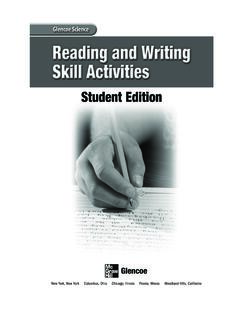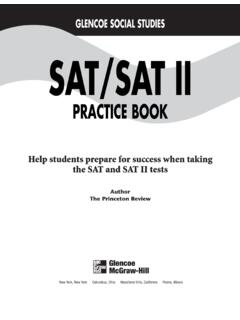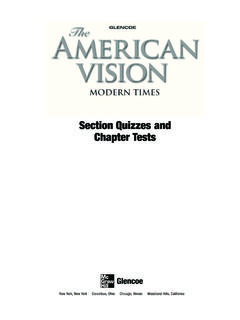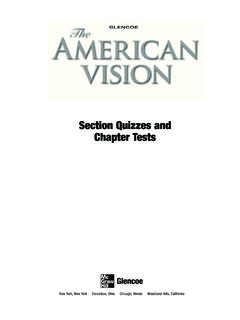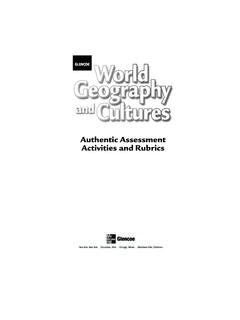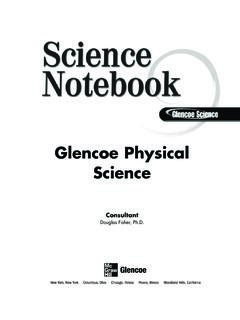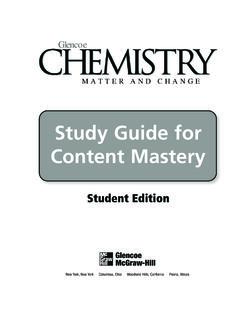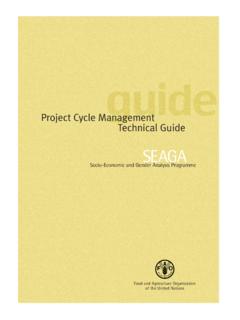Transcription of Focus On Life Science - glencoe.com
1 Reading EssentialsAn Interactive Student Textbook OnLife ScienceCopyright by the McGraw-Hill Companies, Inc. All rights reserved. Except as permitted under the United States Copyright Act, no part of this publication may be reproduced or distributed in any form or by any means, or stored in a database or retrieval system, without the prior written permission of the all inquiries to: glencoe /McGraw-Hill8787 Orion PlaceColumbus, OH 43240-4027 ISBN-13: 978-0-07-879436-0 ISBN-10: 0-07-879436-6 Printed in the United States of America1 2 3 4 5 6 7 8 9 10 047 11 10 09 08 07 glencoe ScienceIn today s world, knowing Science is important for thinking critically, solving problems, and making decisions.
2 But understanding Science sometimes can be a Essentials takes the stress out of reading, learning, and understanding Science . This book covers important concepts in Science , offers ideas for how to learn the information, and helps you review what you have each chapter: Before You Read sparks your interest in what you ll learn and relates it to your world. Read to Learn describes important Science concepts with words and graphics. Next to the text you can find a variety of study tips and ideas for organizing and learning information: The Study Coach offers tips for getting the main ideas out of the text. Foldables Study Organizers help you divide the information into smaller, easier-to-remember concepts.
3 Reading Checks ask questions about key concepts. The questions are placed so you know whether you understand the material. Think It Over elements help you consider the material in-depth, giving you an opportunity to use your critical-thinking skills. Picture This questions specifically relate to the art and graphics used with the text. You ll find questions to get you actively involved in illustrating the concepts you read about. Applying Math reinforces the connection between math and Science . Academic Vocabulary defines some important words that will help you build a strong main California Science Content Standard for a lesson appears at the beginning of each lesson.
4 This statement explains the essentials skills and knowledge that you will be building as you read the lesson. A complete listing of the Grade Seven Science Content Standards appears on pages iv to for yourself, Reading Essentials makes Science enjoyable and easy to the StudentiiiTable of ContentsTo the Student .. iiCalifornia Science Standards .. ivChapter 1 Cell Structure and Function .. 1 Chapter 2 From a Cell to an Organism .. 15 Chapter 3 Reproduction of Organisms .. 25 Chapter 4 Genetics.. 47 Chapter 5 The Process of Evolution.. 59 Chapter 6 Evolution Evidence of Change .. 69 Chapter 7 The Age of Earth .. 81 Chapter 8 The History of life on Earth.
5 93 Chapter 9 The Musculoskeletal System and Levers .. 107 Chapter 10 The Cardiopulmonary System and Pressure .. 115 Chapter 11 The Eye and Light .. 125 Chapter 12 The Ear and Sound .. 139 Chapter 13 The Human Reproductive System .. 147 Copyright glencoe /McGraw-Hill, a division of The McGraw-Hill Companies, 7 Science Content Standards1. All living organisms are composed of cells, from just one to many trillions, whose details usually are visible only through a microscope. As a basis for understanding this concept: a. Students know cells function similarly in all living organisms. b. Students know the characteristics that distinguish plant cells from animal cells, including chloroplasts and cell walls.
6 C. Students know the nucleus is the repository for genetic information in plant and animal cells. d. Students know that mitochondria liberate energy for the work that cells do and that chloroplasts capture sunlight energy for photosynthesis. e. Students know cells divide to increase their numbers through a process of mitosis, which results in two daughter cells with identical sets of chromosomes. f. Students know that as multicellular organisms develop, their cells differentiate. 2. A typical cell of any organism contains genetic instructions that specify its traits. Those traits may be modified by environmental influences. As a basis for understanding this concept: a. Students know the differences between the life cycles and reproduction methods of sexual and asexual organisms.
7 B. Students know sexual reproduction produces offspring that inherit half their genes from each parent. c. Students know an inherited trait can be determined by one or more genes. d. Students know plant and animal cells contain many thousands of different genes and typically have two copies of every gene. The two copies (or alleles) of the gene may or may not be identical, and one may be dominant in determining the phenotype while the other is recessive. e. Students know DNA (deoxyribonucleic acid) is the genetic material of living organisms and is located in the chromosomes of each cell. 3. Biological evolution accounts for the diversity of species developed through gradual processes over many generations.
8 As a basis for understanding this concept: a. Students know both genetic variation and environmental factors are causes of evolution and diversity of organisms. b. Students know the reasoning used by Charles Darwin in reaching his conclusion that natural selection is the mechanism of evolution. c. Students know how independent lines of evidence from geology, fossils, and comparative anatomy provide the bases for the theory of evolution. d. Students know how to construct a simple branching diagram to classify living groups of organisms by shared derived characteristics and how to expand the diagram to include fossil organisms. e. Students know that extinction of a species occurs when the environment changes and the adaptive characteristics of a species are insufficient for its survival.
9 Iv4. Evidence from rocks allows us to understand the evolution of life on Earth. As a basis for understanding this concept: a. Students know Earth processes today are similar to those that occurred in the past and slow geologic processes have large cumulative effects over long periods of time. b. Students know the history of life on Earth has been disrupted by major catastrophic events, such as major volcanic eruptions or the impacts of asteroids. c. Students know that the rock cycle includes the formation of new sediment and rocks and that rocks are often found in layers, with the oldest generally on the bottom. d. Students know that evidence from geologic layers and radioactive dating indicates Earth is approximately billion years old and that life on this planet has existed for more than 3 billion years.
10 E. Students know fossils provide evidence of how life and environmental conditions have changed. f. Students know how movements of Earth s continental and oceanic plates through time, with associated changes in climate and geographic connections, have affected the past and present distribution of organisms. g. Students know how to explain significant developments and extinctions of plant and animal life on the geologic time scale. 5. The anatomy and physiology of plants and animals illustrate the complementary nature of structure and function. As a basis for understanding this concept: a. Students know plants and animals have levels of organization for structure and function, including cells, tissues, organs, organ systems, and the whole organism.
